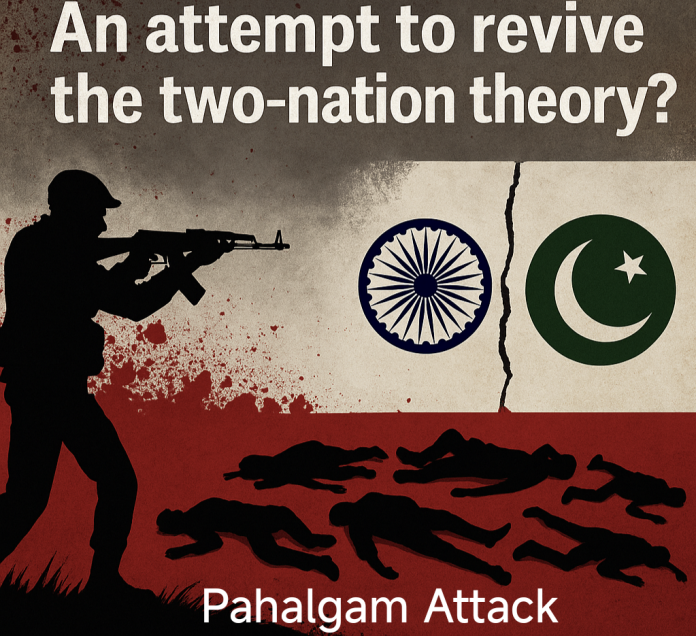NEW DELHI: The gruesome terrorist attack in Pahalgam, where 26 tourists were mercilessly killed in front of their families—including children and women—demands deeper reflection. Eyewitnesses suggest that the attackers identified victims based on religion before killing them, pointing to a chilling motive beyond ordinary terrorism.
This wasn’t just an act of violence. It appeared calculated, ideological. But what ideology was at play? Government responses have so far lacked depth, simply blaming foreign hands. However, there’s more beneath the surface that must be unpacked.
Former diplomat Jawed Ashraf offered an important insight. At the Indian Express Idea Exchange Programme, he stated that the attack’s real aim was to spark communal conflict in India and promote the dangerous belief that Hindus and Muslims cannot live together peacefully. In his view, the perpetrators intended to revive the two-nation theory and destabilize the region, especially at the start of the tourist season.
This raises a disturbing question: why are forces trying to resurrect the very ideology that led to the Partition of India in 1947? Could it be that the ground reality in present-day India is giving them confidence that the theory might once again gain traction?
Over the past decade, political analysts and civil society have observed a growing marginalization of Muslims in politics, governance, and society. The BJP-led central government and its state administrations have frequently been accused of sidelining Muslims and creating a climate of fear.
The evidence is everywhere—in headlines, in reports, and in the lived experiences of millions. From Uttar Pradesh to Gujarat, and from Madhya Pradesh to Assam, Muslims have faced targeted demolitions of homes and religious structures, police crackdowns, and denial of equal opportunity. Even in Delhi, where BJP has gained increasing influence by undermining AAP’s authority, the Muslim community feels cornered.
Since Narendra Modi took power in 2014, Muslim institutions—mosques, madrasas, dargahs, schools, and even graveyards—have come under threat. Bulldozers have become a symbol of state-sponsored punishment, disproportionately affecting Muslim localities after any unrest.
Madrasas have been labeled as “centres of extremism” without evidence, and several historic mosques—like the Shahi Eidgah in Mathura and the Gyanvapi mosque in Varanasi—are facing legal challenges. The Supreme Court’s 2019 verdict that handed over Babri Masjid land to Hindu claimants, despite acknowledging its illegal demolition, only deepened this sense of injustice.
The recent Waqf Amendment Act of 2025, now challenged in court, could allow governments to seize thousands of Muslim religious properties—including prominent mosques and graveyards—posing another serious concern for the community.
The 2019 Citizenship Amendment Act (CAA) further alienated Muslims. It offers citizenship to illegal migrants from neighboring countries—except Muslims. If implemented alongside the NRC, it could potentially render many Indian Muslims stateless. Assam already witnessed such effects, which sparked nationwide protests.
Mob lynchings, often committed with impunity, have become alarmingly frequent. Victims are often Muslim, and justice is rare. Meanwhile, Muslim businesses are being boycotted during Hindu festivals and in religious spaces. At the Mahakumbh mela this year in Prayagraj, Muslims weren’t allowed to set up stalls.
Even religious practices are being restricted. Offering Eid prayers in open spaces—often due to lack of room in mosques—is being treated as a crime. Such restrictions apply to everyone, from local residents to elected officials.
Prime Minister Modi’s own language has been criticized for contributing to the problem. Referring to protesters by their “clothes” or using terms like “puncturewala” reinforces harmful stereotypes. These comments, alongside official policies, send a message of exclusion.
This climate of marginalization recalls the dangerous rhetoric of pre-independence ideologues like Savarkar and Golwalkar, who believed Hindus and Muslims couldn’t coexist. When internal politics feeds this divisiveness, it becomes easier for external enemies to exploit the situation—as they seemingly did in Pahalgam.
Yet, Indian Muslims continue to reject this narrative. Muslim groups across the country strongly condemned the Pahalgam killings, standing with the victims’ families. The community has consistently resisted the idea of separation and chose to stay in India in 1947 despite the option of migrating to Pakistan.
The response to the Pahalgam tragedy proves once again that Indian Muslims remain firmly committed to unity, coexistence, and national integrity. Their loyalty is not shaken by violence or discrimination—it is deepened by it.
It’s time for the ruling governments—both at the Centre and in the states—to introspect. Rather than pushing Muslims to the margins, they must ensure equal rights, justice, and protection for all citizens. Only then can India truly rise above divisive ideologies and fulfill the promise of a secular democracy.




